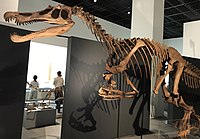Suchosaurus
| Suchosaurus | |
|---|---|

| |
| Holotype tooth of S. cultridens seen from two angles | |
| Scientific classification | |
| Domain: | Eukaryota |
| Kingdom: | Animalia |
| Phylum: | Chordata |
| Clade: | Dinosauria |
| Clade: | Saurischia |
| Clade: | Theropoda |
| Family: | †Spinosauridae |
| Subfamily: | †Baryonychinae |
| Genus: | †Suchosaurus Owen, 1841 |
| Type species | |
| †Suchosaurus cultridens Owen, 1841
| |
| Species | |
| |
| Synonyms | |
| |
Suchosaurus (meaning "crocodile lizard") is a
History of discovery
In about 1820, British
In 1897, French palaeontologist
During the nineteenth and most of the twentieth century, Suchosaurus was usually considered to have been some obscure crocodilian, perhaps belonging to the Pholidosauridae.[11] Single comparable teeth discovered in England were referred to the genus.[7] However, when publishing a redescription of Baryonyx in 1998, British palaeontologist Angela Milner realised that the teeth of that spinosaurid dinosaur were extremely similar to those of Suchosaurus. In 2003, she suggested both genera represented one and the same animal.[12] An identity would imply the name Suchosaurus has priority. However, the Suchosaurus teeth are also indistinguishable from those of Cristatusaurus and Suchomimus, making it an indeterminate baryonychine.[citation needed]

In 2007, French palaeontologist
Description

In 2012,
Palaeoecology
The Wadhurst Clay Formation, part of the
References
- ^ Mantell, G.A., 1822, The fossils of the South Downs or Illustrations of the Geology of Sussex, London, Rupton Relfe
- ^ Cuvier, G., 1824, Recherches sur les ossemens fossiles, deuxième édition. Dufour & d’Ocagne, Paris. 547 pp
- ^ Mantell, G.A., 1827, Illustrations of the geology of Sussex, London, Lupton Relfe. 92 pp
- ^ Owen, R. (1840–1845). Odontography. London: Hippolyte Baillière, 655 pp, 1–32
- ^ Owen, R., 1842, Report on British fossil reptiles. Part II. Reports of the meetings of the British Association for the Advancement of Science. 11, pp 61-204
- ^ Owen, R., 1878, Monograph on the fossil Reptilia of the Wealden and Purbeck Formations. Supplement VIII, (Goniopholis, Petrosuchus, and Suchosaurus). Palaeontolographical Society Monographs, 32, pp 1-15
- ^ a b Lydekker, R., 1888, Catalogue of the Fossil Reptilia and Amphibia in the British Museum (Natural History), Cromwell Road, S.W., Part 1. Containing the Orders Ornithosauria, Crocodilia, Dinosauria, Squamata, Rhynchocephalia, and Proterosauria. British Museum of Natural History, London. 309 pp
- ^ *Owen, R., 1884, A History of British Fossil Reptiles, Volume II. Cassell, London. 224 pp
- ^ Sauvage, H. E. (1897–1898). Vertébrés fossiles du Portugal. Contribution à l’étude des poissons et des reptiles du Jurassique et du Crétacique. Lisbonne: Direction des Travaux géologiques du Portugal, 46p
- ^ Malafaia, E.; Ortega, F.; Escaso, F.; Mocho, P., 2013, "Rediscovery of a lost portion of the holotype of Suchosaurus girardi (Sauvage, 1897-98), now related to the spinosaurid theropod Baryonyx", In: Torcida Fernández-Baldor, F.; Huerta, P. (Eds.). Abstract book of the VI International Symposium about Dinosaurs Palaeontology and their Environment pp 82-84
- ^ Buffetaut, E., 2010, "Spinosaurs before Stromer: Early finds of spinosaurid dinosaurs and their interpretations", Geological Society, London, Special Publications. 343, pp 175-188
- ^ Milner, A., 2003, "Fish-eating theropods: A short review of the systematics, biology and palaeobiogeography of spinosaurs". In: Huerta Hurtado and Torcida Fernandez-Baldor (eds.). Actas de las II Jornadas Internacionales sobre Paleontologýa de Dinosaurios y su Entorno (2001). pp 129-138
- ^ .
- ^ Holtz, Thomas R. Jr. (2011) Dinosaurs: The Most Complete, Up-to-Date Encyclopedia for Dinosaur Lovers of All Ages, Winter 2010 Appendix.
- ^ Holtz, T. R. Jr. (2014). "Supplementary Information to Dinosaurs: The Most Complete, Up-to-Date Encyclopedia for Dinosaur Lovers of All Ages". University of Maryland. Retrieved 2014-09-05.
- ISBN 9780565094973.
- ^ Hopson, P.M., Wilkinson, I.P. and Woods, M.A. (2010) A stratigraphical framework for the Lower Cretaceous of England. Research Report RR/08/03. British Geological Survey, Keyworth.
- ^ Lake, R.D. & Shepard-Thorn, E.R. (1987) Geology of the country around Hastings and Dungeness: Memoir for 1:50,000 geological sheets 320 and 321. British Geological Survey, London.
- ISBN 978-0-520-24209-8.
- .
- S2CID 18562271.
- .
- ^ Simpson, G. G. (1928). "A catalogue of the Mesozoic mammalia in the geological department of the British Museum". London: British Museum (Nat Hist).
- S2CID 39141524.
- ^ Foster, J. (2007). "Appendix." Jurassic West: The Dinosaurs of the Morrison Formation and Their World. Indiana University Press. pp. 327-329.
- ^ "Spalacotherium Owen 1854 - Encyclopedia of Life". eol.org. Retrieved 2020-04-21.
External links


- First post of a long discussion of Suchosaurus as a dinosaur and its implications, in the Dinosaur Mailing List Archives
